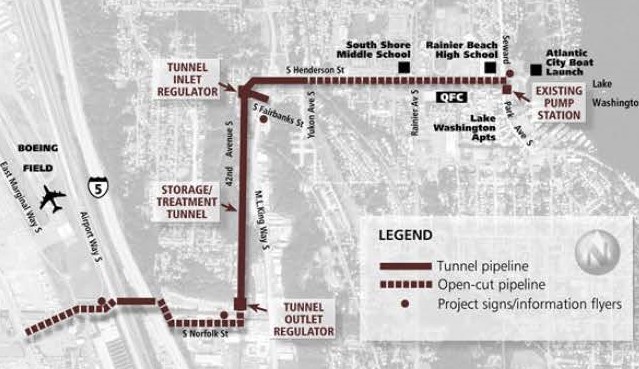Henderson/M.L. King CSO control, Seattle (2005)
Completed – Fall 2005
This project is one of King County's largest combined sewer overflow control projects. Besides helping protect the water quality of Lake Washington, it provides many needed improvements to the Rainier Beach sewer system, much of which is more than 50 years old.
Before this project, 30 million to 60 million gallons of combined waste and stormwater overflowed to Lake Washington every year from King County combined sewer overflows (CSOs). With the project complete, CSOs will be dramatically reduced, and our beaches will be cleaner and safer.

How construction occurred
Begun in September 2002, the project was completed in August 2005. The last year of construction consisted primarily of completing the two key regulator stations at each end of the CSO storage tunnel. The project's six tunnels were completed in early 2004, and open-trench work on South Norfolk Street and South Henderson Street was finished in late 2003.
The project alignment begins in the north at the Henderson Pump Station at Seward Park Avenue South and South Henderson Street. It ends on East Marginal Way S near the Duwamish Waterway.
Work on the project's six tunnels required heavy construction equipment, installation of open-cut pipelines, tunnel boring, deep shaft excavation and related earth moving.
Inside the combined sewer storage tunnel
The underground storage tunnel has an inside diameter of about 15 feet. It runs two-thirds of a mile to the south under Beacon Hill at depths of 30 to 100 feet beneath 42nd Avenue South.
The tunnel can hold and treat up to 4 million gallons of combined wastewater and stormwater. Temporarily storing combined sewage in the tunnel provides time for storms to pass and flow levels to subside in pipelines throughout the King County wastewater system. Similar underground storage facilities are also located under Denny Way just north of downtown Seattle and at Alki Point in West Seattle.
After flows have decreased and the system's regional wastewater treatment facilities have enough capacity, all flows that have been stored and treated in the new Beacon Hill tunnel are drained through an outlet regulator at the south end of the tunnel. The regulator is in the Norfolk Industrial Park at 42nd Avenue South and South Norfolk Street.
As the flows are drained from the tunnel, they are conveyed west in 72-inch pipelines under Interstate 5 and rail lines to Airport Way South. From there, flows can be sent to either the West Point Treatment Plant in Seattle's Magnolia area or the South Treatment Plant in Renton, depending on existing capacities and system needs. In rare occasions after severe storms, and if the region's two treatment facilities are at capacity, treated flows could also be safely released to an outfall in the Duwamish Waterway.
How the new CSO project helps protect Lake Washington and Rainier Beach
Pumping storm flows away from Lake Washington
The Henderson Pump Station—located across from Lake Washington, the Atlantic City Boat Ramp, and Beer Sheva Park at Seward Park Avenue South and South Henderson Street—is the project's most visible facility. The former Municipality of Metropolitan Seattle (Metro) built it in the mid-1970s with a capacity to pump 7.5 million gallons per day of combined sewage. It replaced an older, smaller City of Seattle pump station that sat across the street next to Rainier Beach High School.
Today, the newly expanded Henderson Pump Station has nearly tripled in capacity while maintaining the same footprint. It can carry more than 20 million gallons of stormwater and wastewater a day away from the lake during and after heavy rainfalls.
Most of the pump station's expansion is not obvious from the street because it's taken place underground. With five variable speed pumps, this state-of-the-art facility can now collect peak wet-weather flows, which previously overflowed to Lake Washington. From the pump station, flows are pumped west below Henderson Street through new 42- to 72-inch pipelines to a new combined sewer storage tunnel.
Regulating incoming flows to the combined sewer storage tunnel
The beginning of the storage tunnel is at 42nd Avenue South between Fairbanks Avenue South and Carkeek Drive South. Flows entering the tunnel pass through an inlet regulator, a multilevel underground facility that diverts wet weather flows into the combined sewer storage and treatment tunnel.
The inlet regulator is a fairly small, one-story building above ground in a parklike setting. But the facility reaches 80 feet underground in five levels to house advanced electrical controls, an emergency generator, flow control gates, odor control equipment and a hypochlorite disinfection system.

 Translate
Translate